Adrenaline-Filled Adventures on the Best Safaris in Uganda: The Home of Jungles, Savannahs, and Wildlife
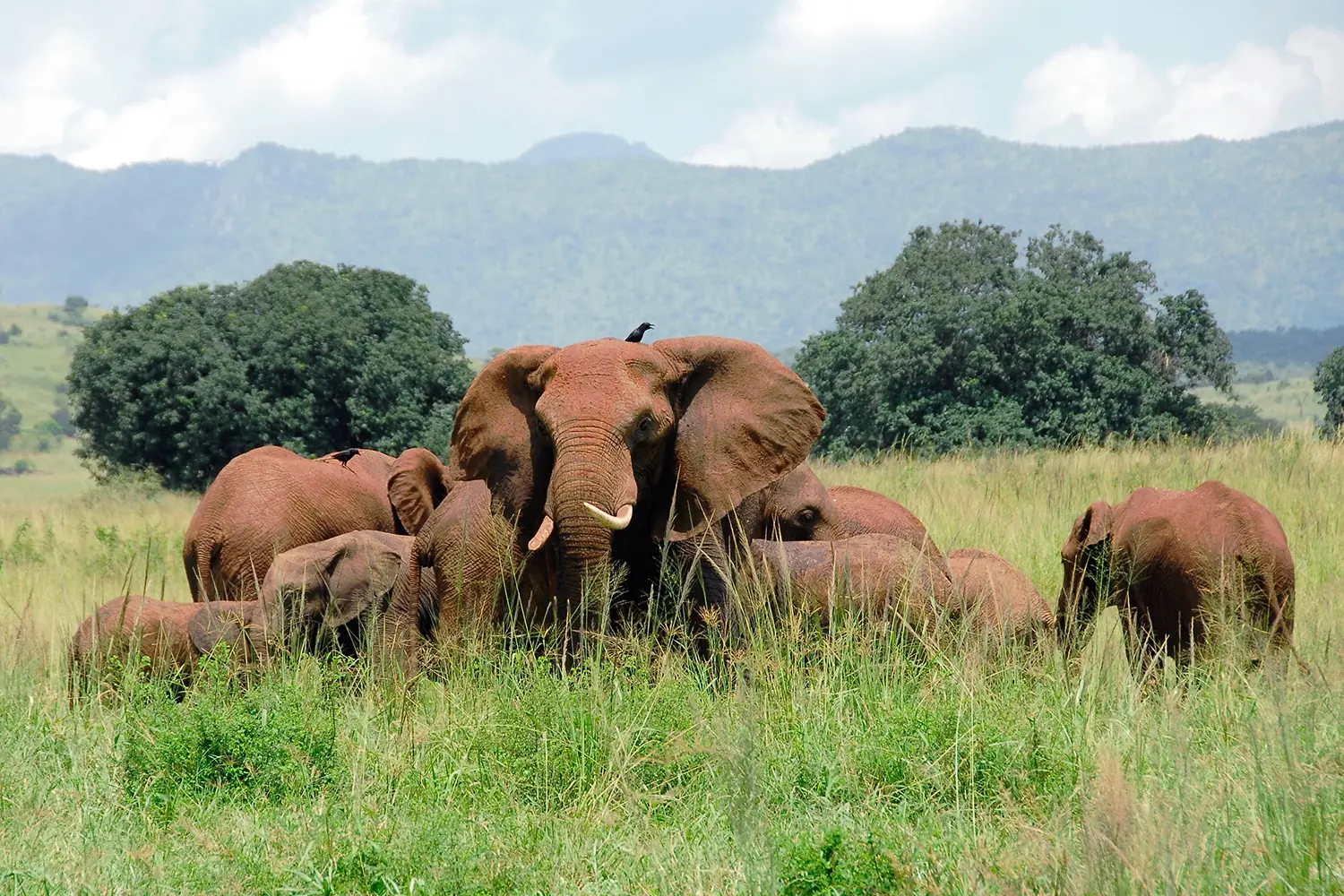
If you’re looking for a wholesome safari destination in East Africa, Uganda is worth adding to your bucket list. Well, where else can you lock eyes with mountain gorillas on one day, track chimpanzees the next, and then enjoy some wildlife viewing experiences after? Only in the dense Bwindi Impenetrable National Park, through the leafy canopies of Kibale Forest National Park, and in Queen Elizabeth National Park.
Stepping into Uganda feels like coming into the heartland of Africa where forested mountains roll gently into open grasslands only broken up by rivers. Its waterfalls are mesmerizing while its scenic valleys are dotted with crater lakes. Coupled with the country’s unique cultural experiences a safari in Uganda is sure to leave you with a lifetime of memories. Come with us and let’s delve into the wonders of Uganda safaris.
Book Your Safari in Uganda With Us
To book your Uganda safari, we invite you to contact us via phone or WhatsApp at +254-704-532-105. You can also connect with us via email at safarioffers@kenyaluxurysafari.co.uk or safarioffers@ajkenyasafaris.com.
Our Senior Consultant, James Gatheru, is on hand to answer all your questions and help you personalise your itinerary.
Uganda Safari Tours - Photos by Our Clients
The Wonders of Safari in Uganda
Unlike neighboring Tanzania or Kenya which boast of unimaginably vast savannah grasslands in the Serengeti National Park or Masai Mara, Uganda is a mix of habitats. Its geographical features include the majestic River Nile, freshwater Lake Victoria, volcanic lakes Albert and Edward, snow-capped Rwenzori Mountains, rugged terrain, dense rainforests, and open savannahs. Eye candy for wildlife enthusiasts looking for a wholesome East African safari tour.
Let’s sample these wonders
Gorilla Trekking Experience in Bwindi Impenetrable National Park
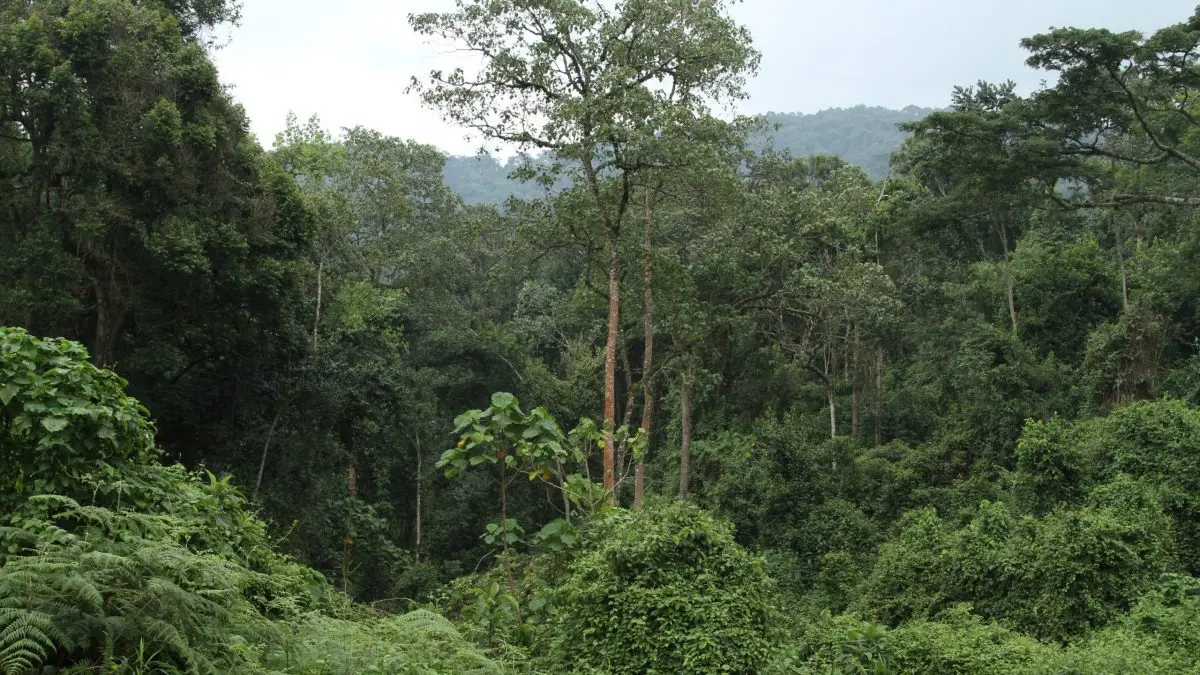
This 25,000-year-old UNESCO World Heritage site is a site to behold. Bwindi Impenetrable Forest feels like a fairy-tale forest. The kind that is wrapped in ancient hardwoods, bamboo thickets, dangling vines, vicious nettles, and delicate fern fronds. Where mountain peaks reach for the skies, perilously steep slopes mark its trails, sparkling waterfalls add zest to mountainous streams and shrouds of mist are a permanent site.
Among those who hide in the dense Bwindi impenetrable forest are mountain gorillas. These powerful primates have muscular arms, massive chests, and broad limbs. They can feel pretty intimidating but they won’t bother or attack people unless provoked. Thanks to continued Gorilla habituation programs, many wild Mountain gorillas are now accustomed to human presence and will go about their lives unperturbed.
Bwindi impenetrable forest is also a feast for the senses. Endowed with thick natural vegetation comprised of over 400 plant species(including trees), over 120 mammal species, birds and butterflies, there is plenty to see, touch, and smell. What starts as a gorilla trek along untamed trails quickly turns into a revitalizing nature walk filled with the sounds of the forest and thrilling discoveries.
As you go deeper into the forest, under the guidance of expert rangers, they will lead you to areas where the mountain gorillas were last seen. It’s an awe-striking moment to finally spot a family of mountain gorillas, going about their daily routine. The Silverback male, regal and commanding; the females, gentle and nurturing; the young ones, playful and curious. So close to our kinds of families but so different, free, and in the wild.
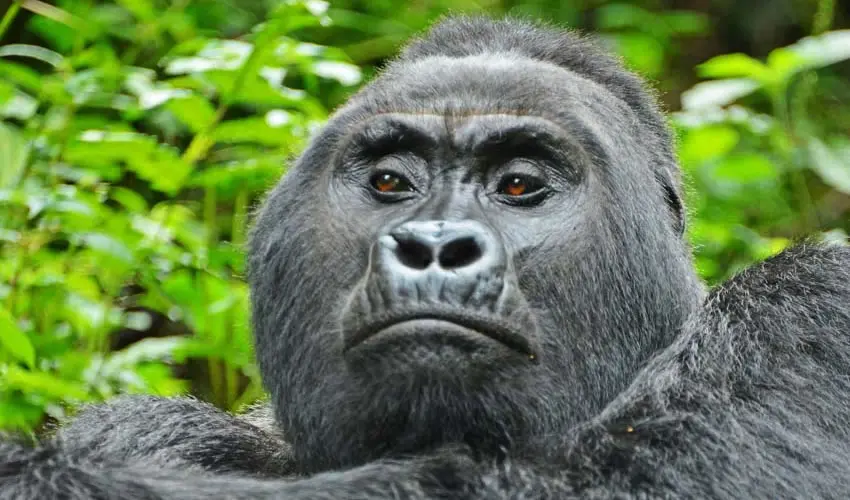
Mgahinga National Park is the only other national park in Uganda where you can see the mountain gorilla. Mgahinga National Park is smaller than Bwindi Impenetrable National Park but still has its fair share of mammals including golden monkeys and bird species.
Before you venture into Bwindi Impenetrable National Park or Mgahinga National Park, you’ll need to secure a Uganda gorilla permit. The government issues limited gorilla trekking permits (152 every day) which means they are often in high demand. You may need to book one well in advance. Gorilla treks can be undertaken all year right, but the dry months of June to August and December are preferable to make the trekking experience less challenging.
As the sun sets on your Uganda gorilla trekking tour and you reflect on the incredible experiences of the day, one thing may become clear. Bwindi Impenetrable Forest National Park isn’t just a park—it’s a world teeming with life and adventure that invites you to step in and explore its secrets.
Chimpanzee Tracking in Kibale Forest National Park
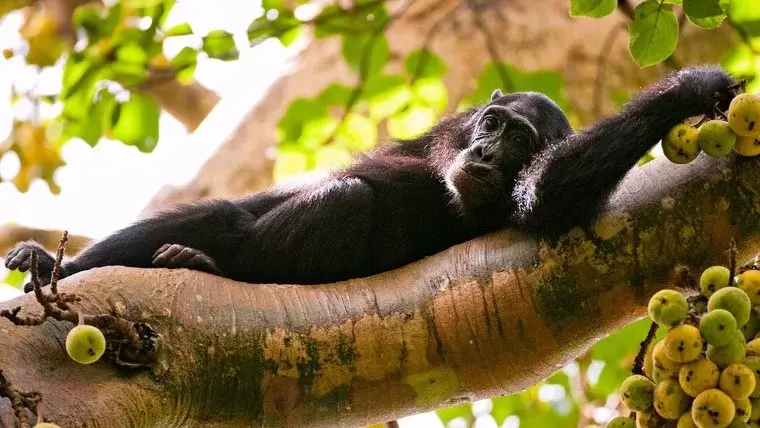
Leaving behind the foggy mountains of Bwindi Forest National Park, we proceed to the verdant expanses of Kibale Forest National Park, Uganda’s premier site for chimpanzee trekking. Sporting a mix of wet and dry tropical forests, woodlands and savannah, the Kibale Forest National Park is home to about 1500 chimpanzees. 12 other primate species, mammals, birds, and butterflies call this forest home.
It’s a top safari destination for chimpanzee trekking and indeed several other primate sightings. Kibale Forest National Park offers unfiltered views of the lives of our closest relatives in the animal kingdom. As you tread softly on the forest floor, your heart races at the sound of a distant hoot. Follow the sound, and you might find yourself looking into the expressive eyes of a chimpanzee. It’s an experience that will leave you feeling a profound connection with the natural world.
As with gorilla trekking, chimpanzee trekking also requires a permit. You can obtain this permit from the Uganda Wildlife Authority or a trusted tour operator. We recommend booking and paying for the permit three to four months earlier to secure a spot. People the world over are as keen to encounter a mountain gorilla as they are chimpanzees.
Kibale National Park is also a birding destination. With various avian species residing in the park, you can look forward to spotting some beautiful and unique birds during your visit.
The best time to visit Kibale National Park for chimpanzee trekking is during the dry seasons from June to August and December to February. During these periods, the chimpanzees are easier to locate as they stay near the ground to feed on fruits. In contrast, the best birding times are in the rainy months of March to May and September to November.
Wildlife Encounters in Queen Elizabeth National Park
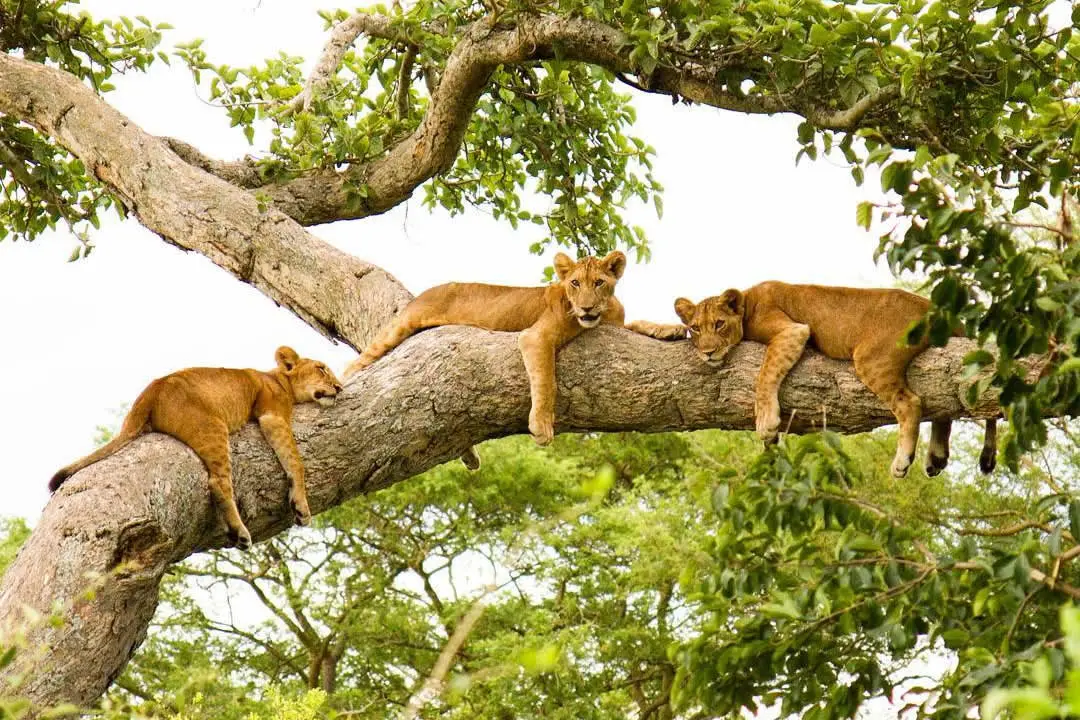
Found in Western Uganda, the Queen Elizabeth National Park is one of the most visited national parks in the list of top Uganda national parks. And rightly so thanks to its combination of savannah grasslands, forests, and water-scapes, and of course its famous tree-climbing lions. Queen Elizabeth National Park is divided into four major sections each boasting a unique attraction.
- Kazinga Channel. A 32km long freshwater channel that hosts a large concentration of hippos and Nile crocs. On a boat cruise across the channel, you’re likely to see these animals alongside elephants, buffalos and waterbirds.
- Kyambura Gorge. Also known as “the valley of apes” the gorge comprises 100m high rock walls encompassing a dense jungle, large crater lakes and boggy swamps. If you’re short on time but still want to enjoy some chimpanzee trekking experiences, you can do that here.
- Mweya Peninsula. This section of the park is covered in chunky grass, thick vegetation and hotels. It also provides direct access to the Kazinga Channel which makes it a popular destination among visitors. Both game drives and guided walks happen here.
- Ishasha sector. Now this is where you’ll find tree-climbing lions lounging nonchalantly in the branches of the park’s enormous fig trees. Scientists believe the lions adopted this strategy to ward off tsetse flies and avoid the scorching heat on the ground. Other wildlife in Ishasha include Ugandan kobs, zebras, buffalos, and elephants.
While the Ishasha section of Queen Elizabeth National Park receives the fewest visitors, it’s ideal for game drives and wildlife viewing. You can enjoy uninterrupted wildlife encounters away from the usual drone of other safari vehicles. The roads, however, aren’t as well maintained as the other popular sections so you’ll need a solid 4×4 safari vehicle to traverse the land.
Murchison Falls National Park: The Mighty Falls & Wildlife
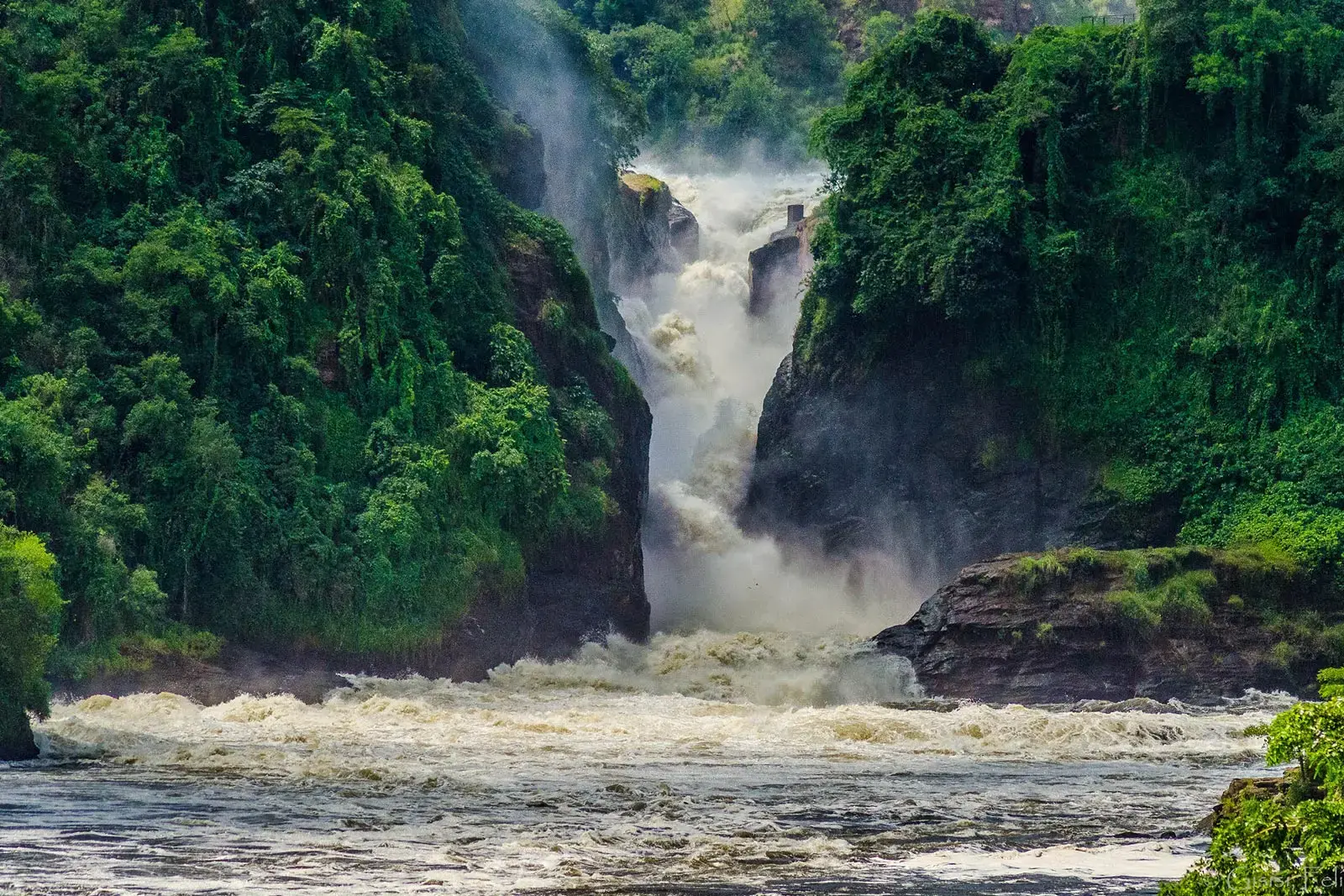
Leaving the tree-climbing lions of Queen Elizabeth National Park behind, we now proceed to the mighty Murchison Falls, a highlight of the national park of the same name. Murchison Falls National Park is Uganda’s largest national park and one of the most diverse. Murchison Falls National Park offers a unique blend of rolling grasslands, wooded savannah, open water, and tropical forests all culminating in stunning landscapes.
At the heart of the park is the mighty Murchison Falls, where the Nile River plunges over a 45-meter-high cliff into a narrow gorge with an impressive roar. You can take a boat cruise to watch this beautiful spectacle at the bottom or hike to the top of the Murchison Falls where it all begins.
Murchison Falls National Park offers a variety of activities, including game drives, hot air balloons, and boat cruises. The Buligi Peninsula track and Albert Delta track are excellent for wildlife viewing. On these game drives, you’re likely to encounter elephants, giraffes, buffalos, leopards, lions, hippos, crocodiles, and aquatic birds.
If you’re looking for an intimate experience, the Kaniyo Pabidi, Rabongo, and Budongo forests within Murchison Falls National Park are perfect for nature walks. Chimps, olive baboons, blue monkeys, red-tailed monkeys, white and black colobus monkeys, butterflies, and birds call these habitations home. They present fantastic opportunities for bird watching and primate viewing.
And what could beat an evening cruise on the Nile? The Nile River bisects Murchison Falls National Park offering unbeatable views of this gorgeous park along with its wildlife.
Kidepo Valley National Park: Uganda’s Hidden Gem
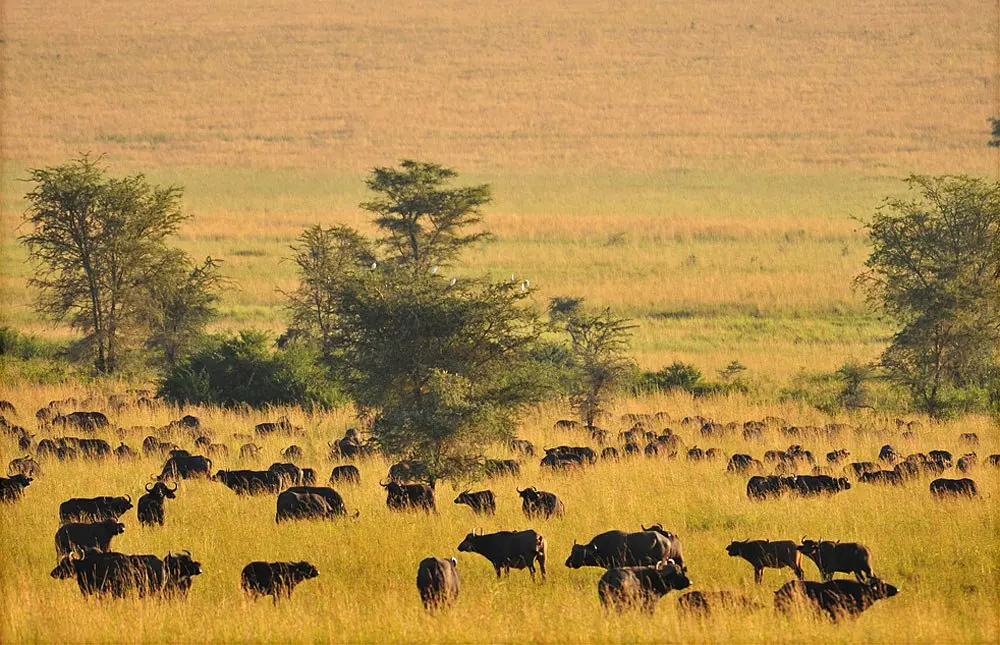
Leaving behind the Murchison Falls National Park and its thunderous falls, our journey leads us to the secluded wilderness of Kidepo Valley National Park. This undiscovered gem in Uganda’s diverse assortment of parks is nestled in the far northern part of Uganda and promises a Uganda safari experience that’s as unspoiled as it is unforgettable.
Leading attractions at Kidepo Valley National Park include
- Narus Valley. The Narus River is a permanent river source in the Narus Valley meaning most wildlife congregate here to quench their thirst. It’s a prime location for spotting big game.
- Mount Morungole. Hiking up Mount Murungole allows you to capture the park’s beautiful scenery and spot various wildlife and birds. The IK tribe lives in these mountains and you get the chance to interact with the people and learn their ways.
- Kanangorok Hot Springs. The Masai people have long believed that the hot springs possess magical healing powers. Besides being a stunning spot for photography and offers magnificent views of its surroundings including the mountain ranges.
The Kidepo Valley in itself is an attraction. The valley doesn’t have as much wildlife as Narus Valley but what Kidepo Valley lacks in big game it makes up with gorgeous scenery. Its grasslands are dotted with rocky outcrops and broken occasionally by the Kidepo River which flows through it. During the dry season, Borassus Palms can be seen along the river bed.
Primate Paradise: Mgahinga Gorilla National Park
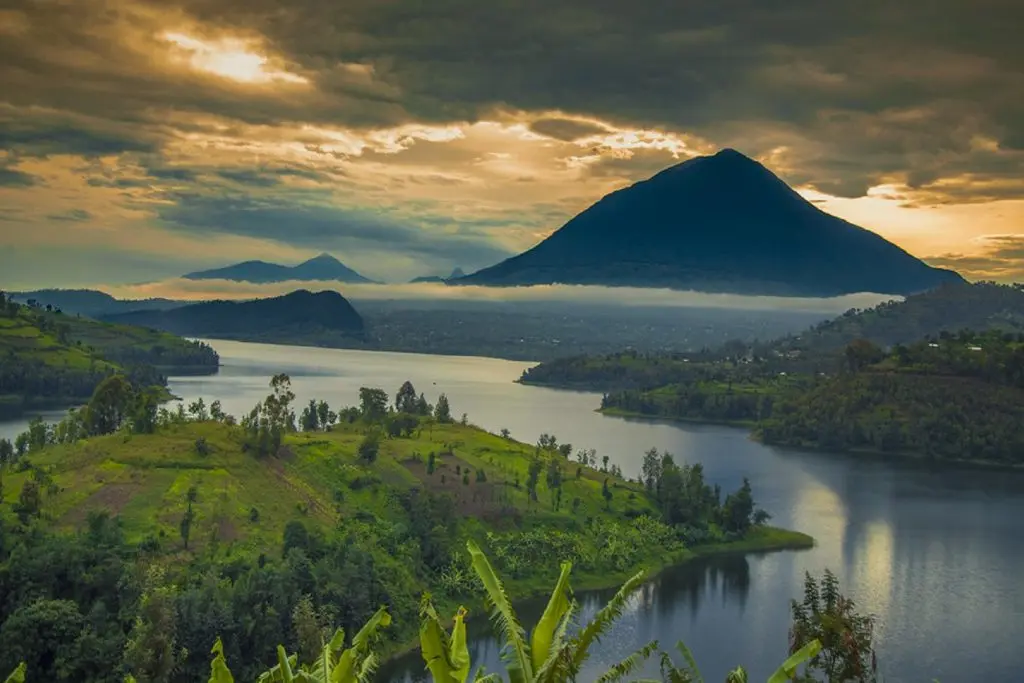
Tucked away in the Virunga Mountains is Mgahinga Gorilla National Park, a haven for primates. Much like Bwindi National Park, Mgahinga is one of the few places in the world where you can see endangered mountain gorillas in their natural habitat. But that’s not all; the park is also home to the rare and beautiful golden monkeys.
Whether it’s gorilla trekking or golden monkey tracking, Mgahinga offers an unforgettable primate experience. The thrill of tracking primates through the dense forest, the anticipation as you near them, and the moment when you finally see them is an experience like no other.
The best trails for primate observation in Mgahinga are the gorilla trekking trail and the golden monkey tracking trail. Both trails offer ample opportunities to spot these primates and observe their behaviour up close.
Lake Mburo National Park: A Compact Wildlife Haven
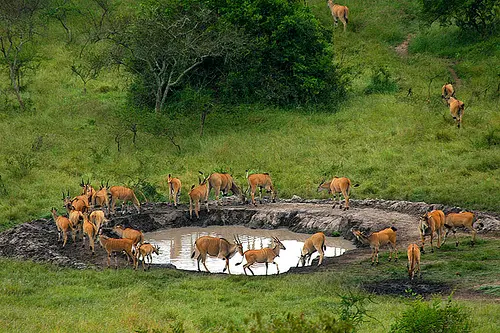
Concluding our list of top Uganda safari tours is the Lake Mburo National Park. Its lakes, woody gorges, Acacia ranges, rocky ranges, swamps, and grassy hills interweave beautifully to make a stunning wildlife reserve.
Despite being one of the smallest national parks in Uganda, Lake Mburo is rich with animal life, including impalas, zebras, and various bird species. And a compact wildlife sanctuary that’s ideal for all kinds of exciting activities. At Lake Mburo Nation Park you can go on
- Game drives to spot diverse wildlife including Topi, Elands, Impalas, Buffalos, Zebras, leopards, jackals, and hyenas
- Bird-watching safari tours to see various avian species including the uncommon shoebill storks, saddle-billed storks, white-winged warblers, and papyrus yellow warblers.
- Boat cruises along the Nile for unique views of the park, and to see hippos, crocs, pelicans, fish eagles, Black crakes, and rare shoebill storks. You just might see some antelopes or buffalos refreshing themselves along the river banks.
- Guided nature walks along the hilly terrain take you to the hilltop where you’ll have panoramic views of Lake Mburo National Park. If you head out early in the morning, you just might spot a hyena heading back to their den after a night’s hunt and a range of colourful birds too.
Other Notable Destinations
You can add other notable attractions to your safari including Ziwa Rhino Sanctuary, Mount Elgon National Park, and Sipi Falls. You can also combine your Uganda safari tours with other safari countries within East Africa. Top East African destinations you can add to your safari itinerary include the Masai Mara and Amboseli in Kenya or the Serengeti and Tarangire National Parks in Tanzania.
Where to Stay on Uganda Safari Tours
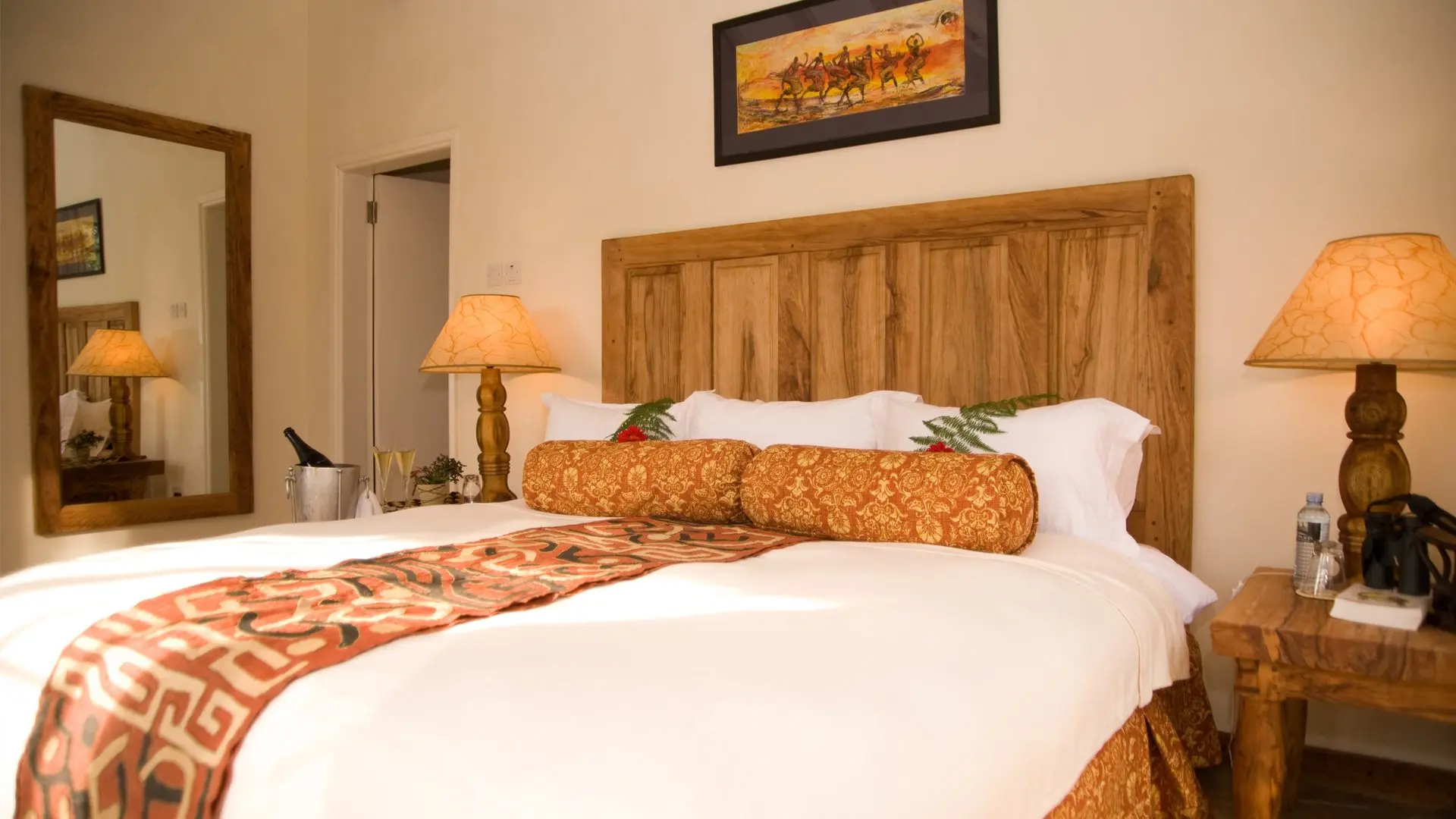
There are several lodges, tented camps, and campsites in the safari destinations we’ve talked about above. We recommend working with reputable Uganda safari tour operators to plan your itinerary and secure your preferred accommodation.
Some of the leading safari lodges include Apoka Safari Lodge, Clouds Mountain Gorilla Lodge, Kyaninga Lodge and Mweya Safari Lodge. Once you and at the Entebbe International Airport, the operator will be there to meet you and get you started on your Uganda safari.
Summary
From impenetrable forests to the powerful Murchison Falls, gorilla trekking, Chimpanzee tracking and game drives, Uganda boasts amazing wildlife encounters, landscapes and cultural experiences. You get an opportunity to immerse yourself in the beauty and wonder of nature, encounter wildlife in their natural habitat, and engage with vibrant cultures. A definite must-visit for any wildlife enthusiast. So, are you ready for an unforgettable wildlife adventure in Uganda?
Frequently Asked Questions
What Are the Best Months for Safari in Uganda?
December to February and June to August are the two dry seasons in Uganda and the best time to go on a Uganda safari.
Does Uganda Have Good Safaris?
Yes, Uganda has good safaris. Uganda’s national parks are ideal for game viewing, boat excursions, primate tracking, and nature walks. You can track mountain gorillas, experience the Murchison Falls, go sport fishing, and enjoy relaxed drives.
How Much Does a Safari Cost in Uganda?
On average, it will cost you $200 per person per day, plus an additional $700 for the gorilla permit and $60 for the golden monkey permit per hour. You can find budget accommodation for as low as $100 per night!
